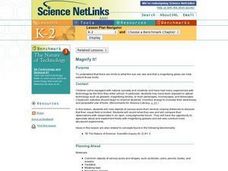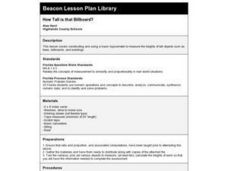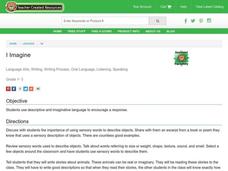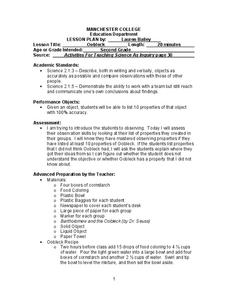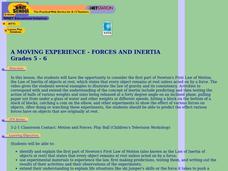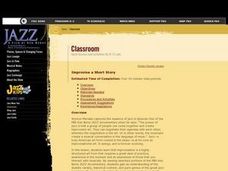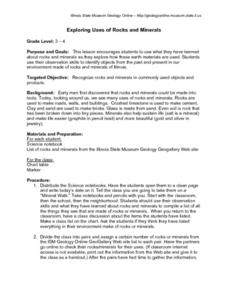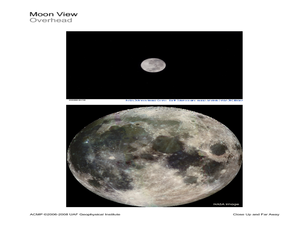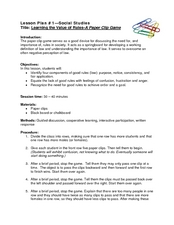Curated OER
Growing Up (And Around, and Down...) Exploring Plant Growth
Students build plant growing structures. In this plant growth lesson, students plant growth structures such as a garden tepee or a crawl through tunnel. They grow plants that are appropriate for the structure.
Curated OER
Magnetic Discovery Bottle
Young scholars examine how to conduct simple investigations and use simple equipment to gather data. In this magnet lesson students decide what types of objects are attracted to magnets.
Curated OER
Magnify It!
Learners explain that there are limits to what the eye can see and that a magnifying glass can help extend those limits. They examine an object with the magnifying glass and draw the size and shape of what they see as accurately as they...
Curated OER
Where is the Preposition?
Provide your pupils with extra preposition practice. Participants are asked to identify the portion of sample sentences that contain the preposition. The lesson could be extended by asking learners to identify the preposition as well. An...
Curated OER
Fabulous Fossils
Seventh graders investigate how fossils are formed and discuss how scientists determine the appearance of ancient plants and animals. They make fossils of everyday objects for others to identify. They make spreadsheets to display fossil...
Curated OER
I Imagine
Students discuss the importance of using sensory words to describe objects; talking about words that refer to size, shape, texture, sound, smell, etc. They select a few objects around the classroom and use sensory words to describe.
Curated OER
Writing Strategies: Descriptive Words
Students discover the importance of using descriptive words in good writing. They brainstorm words to describe elephants and dogs then watch a video that describes different items. Each student writes a paragraph using descriptive words...
Curated OER
Oobleck
Second graders observe the properties of Oobleck. In this science and observation instructional activity, 2nd graders examine Oobleck and make a list of 10 properties that they notice. They explain their observations.
Curated OER
Food Math
Pupils brainstorm healthy food choices. In this health science lesson, students calculate how much of each food group they need daily. They plan a menu based on the "MyPyramid for Kids" food guide.
Curated OER
Polymers, Where Are You?
Learners study polymers and what they are used for. In this investigative lesson students view a video on ploymers, and research on the Internet specific polymers and processes.
Curated OER
Volume of Spheres
Students find the volume of spheres. In this geometry lesson, students measure and derive the formula for each shape and solid. They use the correct terminology and units when solving these problems.
Curated OER
A Moving Experience - Forces and Inertia
Students view a video and complete corresponding activities to observe inertia. They observe and predict the effect various forces have on objects.
Curated OER
Improvise a Short Story through Jazz
Students evaluate jazz music and a jazz music performance. They collaborate and create an improvised group short story. They improvise a musical piece on found objects.
Curated OER
Shape Detectives
Students become "shape detectives" as they identify, name, create and describe common shapes within pictures and objects found within the learning environment. Suggestions include incorporating shapes into all learning areas and daily...
Curated OER
Puzzling Perimeters
Third graders use estimation, fractions and decimals to determine the perimeter of objects in the classroom. They are given a worksheet with a list of the items on it. The worksheet has columns beside each of the items for estimation and...
Curated OER
Exploring Uses of Rocks and Minerals
Young scholars explore the uses of rocks and minerals. They make observations to identify objects from the present and past are made out of rocks.
Curated OER
Close Up and Far Away
Students use magnifiers and telescopes to view things close up. In this magnifiers and telescopes lesson plan, students use the tools to identify things that are close and far away. Students tell details of things they can see closer.
Curated OER
How Does a Satellite Stay in Orbit?
Students explore placing a satellite into orbit, then about forces needed to keep an object in orbit. They examine how satellites orbit in elliptical paths and about properties of ellipses. They learn Kepler's 3rd Law of Planetary Motion
Curated OER
What Does Respect Look Like in School?
Fourth graders discuss why everyone needs and wants to feel respected. As a class, they share what respect looks like and what disrespect looks like. They pretend they have to leave their most valued object with a secret agent and what...
Curated OER
Learning the Value of Rules - A Paper Clip Game
Using a game, learners discuss laws and fairness in society. In order to play the game, they line up in rows in the classroom. The teacher gives them paper clips based on their sex or other criteria. They can begin to discuss issues of...
Curated OER
Measurement Mania
First graders measure 10 different objects found in the classroom, including their own hands and feet, then record their findings. This is a fun lesson for students to experience measurement using a ruler and unifix cubes.
Curated OER
ESL
Students in an ESL classroom practice naming the objects in the classroom. They discover nouns and pronouns. They write in a journal in their native language what they believe to be the most important objects in the room. They practice...
Curated OER
Estimation
Third graders gain an understanding of estimation as an educated guess. They explore measuring and how looking at various object size and shape can help form ones guess towards estimation. They use dinosaurs for an estimation activity.




